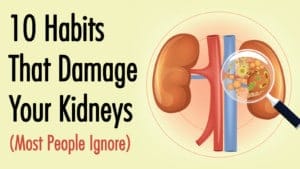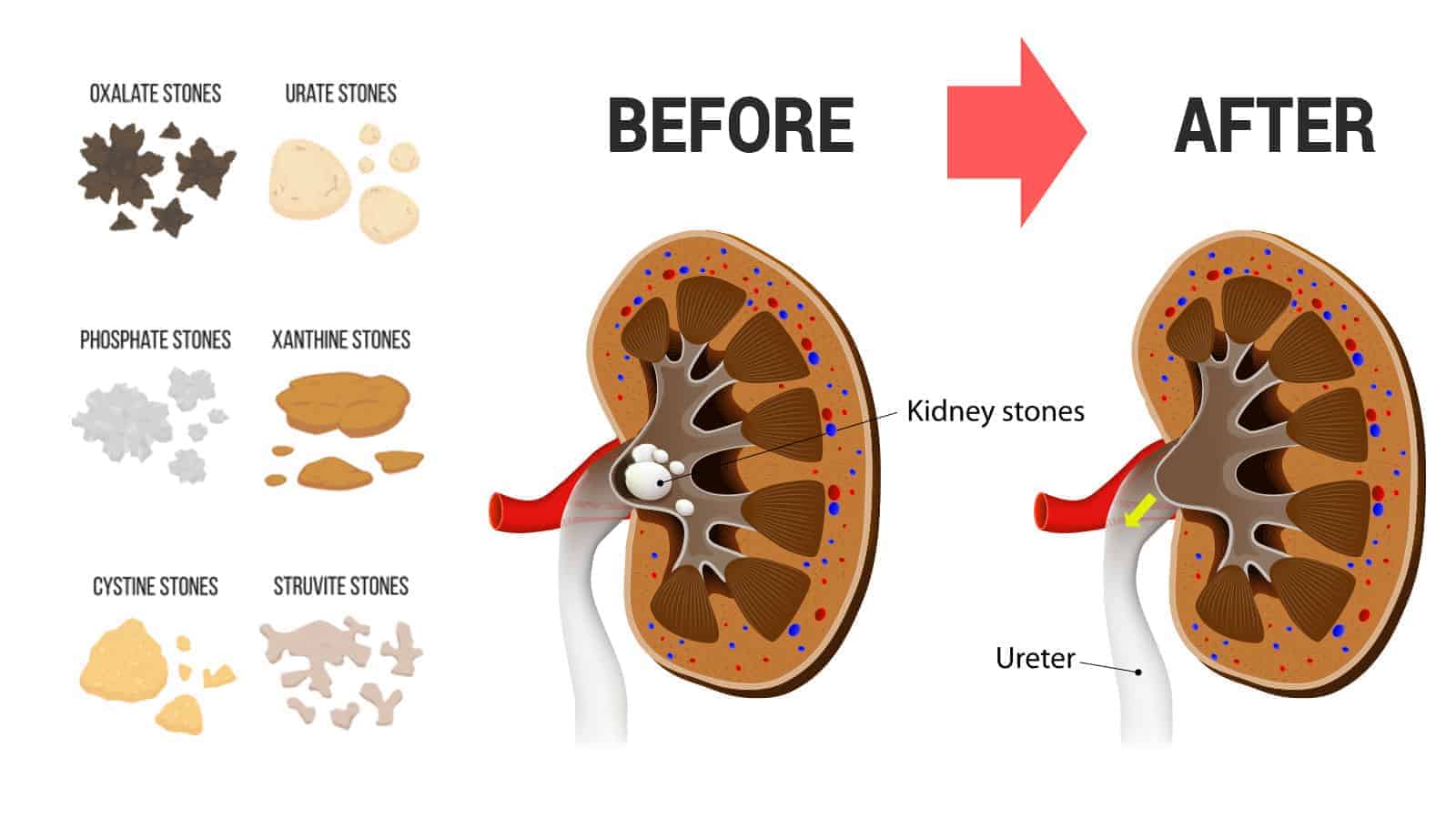You’ve seen the beautiful pictures of calcifications in caves – those amazing crystalline, white formations created from a buildup of salts, calcium, and other minerals over time. They look amazing. When those same crystalline calcifications form in our bodies, however, they are not so fantastic. We can form calcifications on our joints, in our arteries, heart valves, kidneys, bladder, gallbladder, muscles, tendons, and even our breasts and brain. And kidney stones are an extraordinarily painful condition.
Sometimes, they remain relatively symptomless, but other times they can cause problems, such as with kidney stones. Much like how water can eventually wash away the formations in caves, most kidney stones are flushed out through drinking lots of water. It can be excruciating for 2-10 days. Fortunately, researchers reveal a new treatment to help flush kidney stones and hopefully decrease the amount of pain and length of time for them to pass.
How Kidney Stones Form
Our urine contains various waste and minerals. Multiple factors, including not consuming enough water, cause those minerals to accumulate, which can create crystals that, in turn, draw other chemicals to further collect onto the crystals. Typically, our kidneys filter and flush out these wastes as we drink water that our bodies perform specific chemical reactions. For some people, however, these chemicals don’t flush and form into rough, hard stones. The possible compounds that create the stones are:
- Calcium
- Oxalate
- Urate
- Cystine
- Xanthine
- Phosphate
One study proves that there is a correlation between zinc aiding in the formation of kidney stones as well. Plos One published the University of California, San Francisco study. Lead researchers Thomas Chi and Man Su Kim focused on fruit flies, which also tend to develop kidney stones. They previously ascertained that zinc played a factor in how certain chemicals mineralize and crystalize.
They discovered a correlation between zinc and oxalate, a known chemical related to the formation of kidney stones. Their study demonstrated that as zinc levels decreased, there was a change in the amount of oxalate that formed.
Types of Kidney Stones
Depending upon the prevalence of certain chemicals in the stones, kidney stones can be formed into five different types:
-
Calcium Stones:
Despite its name and chemical makeup, calcium stones don’t come from taking or ingesting too much calcium. In reality, dairy foods help decrease the risk of kidney stones. They form from calcium oxalate or calcium phosphate. Calcium oxalate is found in the majority of all kidney stones and has a higher chance of recurring than other stones.
-
Struvite Stones:
These stones occur in about 10% of cases. They are also called infection stones or triple phosphate stones. These occur in individuals who are prone to chronic urinary infections in which urease is commonly produced. Urease is necessary to convert urea into Co2 and ammonia to decrease its alkalinity. When more phosphates form in the urease, the alkalinity is not obtained, causing a buildup of ammonia. More women are prone to this form of kidney stone.
-
Cystine Stones:
This form accounts for only 2% of kidney stones and is genetic. It is a disorder in which amino acids and cysteine don’t transport properly, creating a buildup of cystinuria in the urine. Cystine is either absorbed or leaked into the urine and cannot be absorbed, creating the stones.
-
Stones created from specific drugs:
Certain medications interrupt the breakdown of calcium and other chemicals resulting in creating stones.
-
Uric Acid Stones:
This type makes up about 3-10% of cases and results from a diet high in purines, like animal proteins, creating a condition that reduces urine output and decreases the PH levels. This formation more commonly occurs in men than in women.
Once someone develops kidney stones, they stand an increased risk of them occurring again. Kidney stones may also contribute to multiple severe diseases:
- Chronic Kidney disease
- Renal Failure
- Heart disease
- Diabetes
- High blood pressure
Symptoms of Kidney Stones
Doctors commonly refer to the condition like kidney stones. However, they form in multiple areas of our excretion system. This results in a variety of symptoms based on their location. The symptoms may be:
- Severe cramping in the lower intestinal area
- Pain in the lower back and side, near the rib cage
- Blood in urine
- Urinary tract infections or disease
- Nausea and vomiting
- Weak urine flow from blockage
- Pain while urinating
- Pungent urine odor
- A sensation of wanting to urinate more frequently, despite lack of urine.
- Possibly fever and chills if an infection is present
Contributing factors toward Kidney Stones
According to the National Kidney Association, 1 out of 10 people will develop a kidney stone. The percentage of populace developing kidney stones has been increasing in the last 30-40 years. In 1970, 3.8% of the populace developed stones. In the late 2000s, the percentage rose to 8.8%. 19% of men are likely to develop kidney stones and 9% of women. For men, their chances increase after the age of 30.
Why the increase in kidney stones in the last few decades? Scientists believe it is related to the rise in obesity and possibly due to an increase in global temperatures. That said, no definitive factor has been pinpointed.
The accepted causes of kidney stones, regardless of the recent increase in rates are:
- Inadequate water consumption. We all are familiar with the 8 x 8 rule for drinking water a day. When we are calculating that, we cannot include soda or fruit drinks and must keep activity and heat in mind. On days of higher temperatures or increased activity, we need to increase our fluid intake.
- Not eating enough fruits and vegetables. Fruits and vegetables help to lower the pH of our urine, making our bodies less acidic
- Inherited conditions or diseases
- Chronic urinary infections or kidney infections
- Those who have undergone stomach surgeries
- Those with diabetes, high blood pressure, inflammatory bowel disorder or are obese
- High consumption of certain foods such as animal proteins, high salt or high sugar
 Treatment of Kidney stones
Treatment of Kidney stones
In most cases of kidney stones, treatment consists of drinking a lot of water to flush them out naturally. This can be a harrowing ordeal, particularly for men. Some say that a man flushing out kidney stones is the closest he will get to understand the pain of childbirth. Frequently, a doctor will recommend taking over-the-counter pain killers, and occasionally, a diuretic to help increase urine flow. When the stones are too big to pass, surgery or using shock waves to break up the stones are options.
A new study in Nature Biomedical Engineering shows promise in aiding in the passage of kidney stones through the use of two medications. The study was performed at MIT and Massachusetts General Hospital led by Michael Cima.
Currently, while doctors generally prescribe painkillers, there lacks an FDA-approved medication to aid in relaxing the ureter to allow the stones to pass quickly. The ureter is a small tube that runs from the kidneys to the bladder. It is where the stones pass through. The muscle wall of the ureter becomes inflamed and tense, making passing stones more difficult.
They analyzed over 18 drugs to discover which ones best relaxed the smooth muscle surrounding the tube. They isolated two medications that not only worked individually but worked more effectively together. These medications were nifedipine, a calcium channel blocker commonly used for high blood pressure, and a ROCK inhibitor generally used to treat glaucoma.
Using the combination of these drugs on ureters from pigs, they discovered that the contraction of the muscles was reduced both in frequency and duration. On live pigs, the contractions ceased altogether. The drugs were given directly into the ureter via a scope, and there was no evidence of it leaking into the bloodstream.
The scientists plan on starting trials on humans soon and have great hope in its success to ease the pain and length of time to pass kidney stones. Currently, it can take upwards of 10 days.
 Final Thoughts on New Methods of Managing Kidney Stones
Final Thoughts on New Methods of Managing Kidney Stones
Despite the length of time humankind has had kidney stones, treatments have remained the same over the last 50 years. Painkillers are only slightly effective in making their passing more tolerable, and narcotics have less effect in decreasing the pain. Researchers discovering new treatments to help flush out kidney stones is a great find. Being able to relax the muscles making up the wall of the ureter will not only decrease some of the pain but also allow easier passage of the stones. Hopefully, we can look forward to that treatment soon.












 Community
Community

